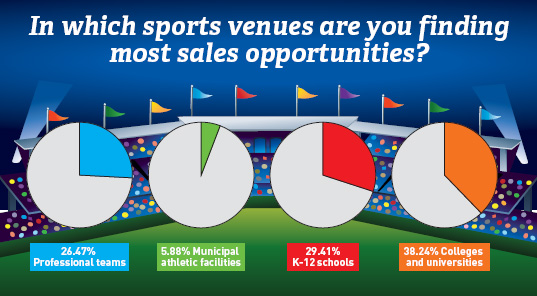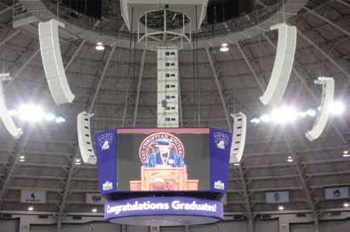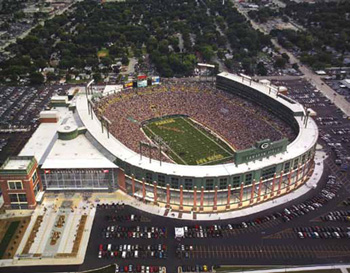Demand for Audio Systems Shifts to Collegiate Sports Retrofits
Despite the lagging economy, retrofit projects on sports venues both domestic and abroad are giving integrators a chance to get in the game. Community Professional Loudspeakers has been involved in projects in both markets, including Green Bay’s Lambeau Field.
With precious few new major sports venues being built in North America currently, not least due to the recession, many audio systems contractors and integrators are focusing on the three Rs: refit, retrofit, and repair.
“I don’t want to be Doctor Doom, but I think this is what’s in our future for the next couple of years,” said Ted Leamy, COO of California-based AV design and installation firm Pro Media/Ultrasound. “I don’t think we’re breaking a lot of new ground in North America right now.”
There are only so many teams in any of the major sports leagues, of course, and expansion is rare. Projects that started well before the recession, such as the New Meadowlands Stadium, Cowboys Stadium, and Lucas Oil Stadium in Indianapolis, are unlikely to be joined any time soon by new construction, although NFL stadiums in San Francisco, Los Angeles, and Minneapolis are being considered.
Jack Wrightson, principal at Wrightson, Johnson, Haddon & Williams (WJHW) in Texas, observed that economic considerations, especially where public money is involved, are undoubtedly limiting the number of new major sports venue projects. “It’s hard to go back to the voters every 15 or 20 years and ask for a new building,” he commented.

So where is the work? “We’re seeing a lot of the collegiate stuff being done with private money,” Wrightson said. “When 2008 hit there was a lot of nervousness and projects went on hold. A year later, the people that have enough money to donate at significant levels realized that the sky wasn’t falling and they started contributing again; a lot of these projects came off hold.”
Stu Schatz, an applications engineer with Bosch Security Systems, concurred. “Where we’re seeing more new systems going in is at the small- to midsized college level. It seems like more of what’s been going on lately is the 6,000- to 15,000- seat venue. I think a lot of that is where the money comes from; a lot of that is alumni stuff.”
As Schatz pointed out, “With the largest of the large venues, it’s never ever going to be a business that will keep five or six contractors nationwide busy all the time. There’s just not enough business. There’s obviously more college level teams. But the typical lifecycle for a system like this is 10 to 15 years.”
One current example of a college renovating its stadium is the University of Notre Dame, he continued. “The last time they redid the sound system or changed anything was back in ’93 or ’94.” The upgrade is at least partly in response to the soundtracks that accompany sporting events these days, Schatz added. “At the time, all they cared about was speech, so it was a whole different sound system requirement than what we’re dealing with now.”
WJHW, too, is involved with the refurbishment of the football stadium sound system at Notre Dame, where a new hockey arena is also under construction.
The aspirations of colleges make them a logical customer on which to focus, Leamy said. “They want to be like the Mavericks or the Green Bay Packers. There’s a lot of work available in the scope of private universities; two in particular that we deal with are Stanford University in California and Baylor in Texas.”
Both those colleges exemplify the drive to give fans an experience at the venue that they can’t get at home, most notably the adoption of in-house HD cameras and screens, said Leamy. In fact, watching a game live is apparently no longer enough of an attraction: at the New Meadowlands fans can watch video feeds via a smart-phone app or 2,200 TV screens, supplementing the stadium’s four jumbo screens, and Cowboys Stadium features two gigantic screens.
As Leamy further observed, “I think video is leading the charge and audio is being dragged along with it. We’re seeing some projects coming off the architects’ and consultants’ drafting tables where it’s being packaged with audio as a subcontract to video.”
But as Leamy also noted, “The key is how well they look after the equipment. I’m not certain that the end user of large sophisticated systems— of all varieties—understand the concept of preventative maintenance and regular service.”
“Things get old and tired and they break,” agreed Wrightson, who noted the need to replace loudspeakers as well as a desire to upgrade technology such as DSP. “That gives you an opportunity to come in with like equipment or upgrade or do something different. If you look at the stuff that was built in the late ’90s and early 2000s, especially for outdoor buildings, it’s starting to hit the end of its life.”
Looking to the future, he added, “I think we’re going to start seeing more networkbased audio transport, to the extent that the existing data network will handle that.”

Upgrading existing systems has been the trend in the past few years. When Texas Christian University in Fort Worth decided to upgrade the sound system in its Daniel-Meyer Coliseum, it relied on Electro-Voice EVA loudspeakers to pack plenty of punch at every seat.
The relative paucity of domestic construction projects has had little effect on Community Professional Loudspeakers, according to VP of business development, John Wiggins, as much of the company’s business is overseas. That said, “Typically, where there’s an outdoor sound system and it requires weather resistance, we’re pretty much always in the mix.”
Community supplied speakers for sections of New Meadowlands and Cowboys Stadium, the TD Ameritrade ballpark in Omaha, NE, and is upgrading Notre Dame’s football field systems. Wiggins, a former racecar driver, has also brought the company work on the international Formula 1 and domestic NASCAR circuits. Community is working with soccer stadiums in Brazil and Europe and has good success with tennis stadiums, according to Wiggins, whose main focus is on new construction.
“We try to stay aware of what all the architects are doing,” he continued. “And they have their favorite acoustical consultants that they work with.”
But as Bosch’s Schatz observed, “Even a couple of years ago, if there was a large venue project going on, there was a consultant involved. That’s just the way it was. I’m starting to hear now with some of the smaller to mid-sized venues that they’re starting to go design-build. That’s not necessarily a trend, but I’m seeing it more and more.”
Steve Harvey (psnpost@nbmedia.com) has been west coast editor for Pro Sound News since 2000 and also contributes to TV Technology and Pro Audio Review. He has 30 years of hands-on experience with a wide range of audio production technologies.
Acoustics Get in The Game
“For most contractors, acoustics have been left on the sideline,” said Peter Janis, president of Radial Engineering. “Not so much because they are not aware of the need, but mostly because they are unfamiliar with the tools at hand. I think there is also a significant difference between a concert hall and an arena.
“Today, pressure from the venue due to complaints from the audience is forcing architects to finally pay attention to the acoustics. The advent of video replay and multi-use events has further advanced the need for acoustics. By applying absorptive panels to wall surfaces, you will decrease the echo or reverberant field. This eliminates the competition from reflections, vastly improving our ability to understand the message being transmitted by the PA system.
“Greater intelligibility can often be achieved by applying 20 percent wall coverage. This in no way will turn an arena into a concert hall, but it will significantly improve intelligibility.
“Sound contractors are much better equipped at providing a solution than a drywall contractor. Audio guys understand sound—they understand dispersion and the importance of mid- and high-frequency transmission lines. In other words, they know what frequencies are important in the voice range or can easily be trained in this area. This is why we are focusing much of our attention these days on ‘lunch and learns,’ clinics, and increasing the educational content on our website.”
—S.H.
